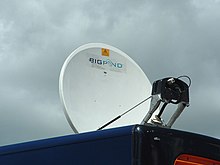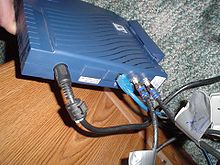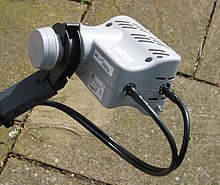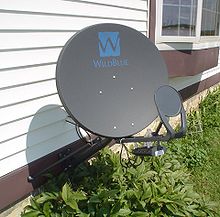It will make a connection where nothing else will work.
The connection will not be fast, cheap or very mobile.
Cable if available does a better job. DSL does a better job.
If the gap is modest between the end of service and "Home" radio links are cheap and easy. Your agency can buy a satellite link for field use.
I can content myself with G3 or G4 connections. Cell service goes most places. Where it does not go, I go because it does not.
http://en.wikipedia.org/wiki/Satellite_Internet_access
Satellite Internet accessFrom Wikipedia, the free encyclopedia
Mechanics and limitations of satellite communicationSignal latencyLatency is the delay between requesting data and the receipt of a response, or in the case of one-way communication, between the actual moment of a signal's broadcast and the time it is received at its destination. Compared to ground-based communication, all geostationary satellite communications experience high latency due to the signal having to travel 35,786 km (22,236 mi) to a satellite in geostationary orbit and back to Earth again. Even at the speed of light (about 300,000 km/s or 186,000 miles per second), this delay can be significant. If all other signaling delays could be eliminated, it still takes a radio signal about 250 milliseconds (ms), or about a quarter of a second, to travel to the satellite and back to the ground.[1] For an internet packet, that delay is doubled before a reply is received. That is the theoretical minimum. Factoring in other normal delays from network sources gives a typical one-way connection latency of 500–700 ms from the user to the ISP, or about 1,000–1,400 ms latency for the total round-trip time (RTT) back to the user. This is much more than most dial-up users experience at typically 150–200 ms total latency, and two orders of magnitude higher than the typical 15-40 ms latency experienced by users of other high-speed internet services, such as cable or VDSL.[2]Geostationary unsuitable for low-latency applications
The internet latency mentioned above may have previously made satellite Internet service problematic for applications requiring real-time user input, such as online games or remote surgery, but newer generation satellites have made latency much less of an issue. Interactive applications, such as VoIP, videoconferencing, or other person-to-person communication such as Skype) work quite well via satellite Internet services now. While some latency still exists, most users won't find it noticeable or bothersome. Latency also impacts the initiation of secure Internet connections such as SSL which require the exchange of numerous pieces of data between web server and web client. Although these pieces of data are small, the multiple round trips involved in the handshake produce long delays compared to other forms of Internet connectivity, as documented by Stephen T. Cobb in a 2011 report published by the Rural Mobile and Broadband Alliance.[3] This annoyance extends to entering and editing data using some Software as a Service or SaaS applications as well as other forms of online work. The functionality of live interactive access to a distant computer -- such as virtual private networks -- is working much better with the new generation of satellite Internet service than in the past. For geostationary satellites, there is no way to eliminate latency, but the problem can be somewhat mitigated in Internet communications with TCP acceleration features that shorten the round trip time (RTT) per packet by splitting the feedback loop between the sender and the receiver. Such acceleration features are usually present in recent technology developments embedded in new satellite Internet services. Acceptable latencies, but lower speeds, of lower orbitsMedium Earth orbit (MEO) and low Earth orbit (LEO) satellites do not have such great delays. The current LEO constellations of Globalstar and Iridium satellites have delays of less than 40 ms round trip, but their throughput is less than broadband at 64 kbit/s per channel. The Globalstar constellation orbits 1,420 km above the earth and Iridium orbits at 670 km altitude. The proposed O3b Networks MEO constellation scheduled for deployment in 2010 would orbit at 8,062 km, with RTT latency of approximately 125 ms. The proposed new network is also designed for much higher throughput with links well in excess of 1 Gbit/s (Gigabits per second). The planned COMMStellation™, scheduled for launch in 2015, will orbit the earth at 1,000 km with a latency of approximately 7 ms. This polar orbiting constellation of 78 microsatellites will provide global backhaul with throughput in excess of 1.2 Gbit/s.Unlike geostationary satellites, low and medium Earth orbit satellites do not stay in a fixed position in the sky. Consequently, ground based antennas cannot be easily locked into communication with any one specific satellite. Communications may involve more diffuse or completely omnidirectional ground antennas capable of communicating with one or more satellites visible in the sky at the same time, but at significantly higher transmit power than fixed geostationary dish antennas, and with much poorer signal to noise ratios for receiving the signal. Tracking a single low earth orbit satellite with a high-gain narrow beam is possible, but requires a motorized antenna mount and complex software that can predict the path of each satellite in the constellation. As with GPS, the small orbits may cause a low Earth orbit satellite to only be in the sky for an hour or less before it goes over the horizon and out of range, so a complex relaying and passing-off needs to be done to hand over the fixed-position terrestrial signal to other satellites passing overhead. Ultralight atmospheric aircraft as satellitesA proposed alternative to geostationary relay satellites is a special-purpose solar-powered ultralight aircraft, which would fly along a circular path above a fixed ground location, operating under autonomous computer control at a height of approximately 20,000 meters[citation needed]. Onboard batteries would be charged during daylight hours by solar panels covering the wings, and would provide power to the plane during night. Ground-based satellite dishes would relay signals to and from the aircraft, resulting in a greatly reduced round-trip signal latency of only 0.25 milliseconds. The planes could potentially run for long periods without refueling. Several such schemes involving various types of aircraft have been proposed in the past.Rain fade A foldable Bigpond satellite Internet dish Rain margins are the extra communication link requirements needed to account for signal degradations due to moisture and precipitation, and are of acute importance on all systems operating at frequencies over 10 GHz.[4] The amount of time during which service is lost can be reduced by increasing the size of the satellite communication dish so as to gather more of the satellite signal on the downlink and also to provide a stronger signal on the uplink. In other words, increasing antenna gain through the use of a larger parabolic reflector is one way of increasing the overall channel gain and, consequently, the signal-to-noise (S/N) ratio, which allows for greater signal loss due to rain fade without the S/N ratio dropping below its minimum threshold for successful communication. Modern consumer-grade dish antennas tend to be fairly small, which reduces the rain margin or increases the required satellite downlink power and cost. However, it is often more economical to build a more expensive satellite and smaller, less expensive consumer antennas than to increase the consumer antenna size to reduce the satellite cost, as the antenna cost reduction is magnified through economies of scale whereas any reduction of the satellite cost is not. Large commercial dishes of 3.7 m to 13 m diameter are used to achieve large rain margins and also to reduce the cost per bit by requiring far less power from the satellite. Satellites typically use photovoltaic solar power, so there is no expense for the energy itself, but a more powerful satellite will require larger, more powerful solar panels and electronics, often including a larger transmitting antenna. The larger satellite components not only increase materials costs but also increase the weight of the satellite, and in general, the cost to launch a satellite into an orbit is directly proportional to its weight. (In addition, since satellite launch vehicles [i.e. rockets] have specific payload size limits, making parts of the satellite larger may require either more complex folding mechanisms for parts of the satellite like solar panels and high-gain antennas, or upgrading to a more expensive launch vehicle that can handle a larger payload.) Modern download DVB-S2 carriers, with RCS feedback, are intended to allow the modulation method to be dynamically altered, in response to rain problems at a receive site. This allows the bit rates to be increased substantially during normal clear sky conditions, thus reducing overall costs per bit. Line of sightTypically a completely clear line of sight between the dish and the satellite is required for the system to work. In addition to the signal being susceptible to absorption and scattering by moisture, the signal is similarly impacted by the presence of trees and other vegetation in the path of the signal. As the radio frequency decreases, to below 900 MHz, penetration through vegetation increases, but most satellite communications operate above 2 GHz making them sensitive to even minor obstructions such as tree foliage. A dish installation in the winter must factor in plant foliage growth that will appear in the spring and summer. Fresnel zoneThe radio signal width between any two antennas is not perfectly straight and uniform, as if it were a beam of light. Instead as the signal propagates away from the transmitting antenna, it widens towards the centerpoint between the two antennas and then narrows again as it approaches the receiving antenna. This is known as the Fresnel zone (named for physicist Augustin-Jean Fresnel), and limits the usefulness of satellite dish antennas in locations where there is extremely limited open sky for signal reception. The signal path through space must be clear not only for direct line of sight, but also for the expanding Fresnel zone, which may be several meters[citation needed] larger in diameter than the ground-based satellite dish.Two-way satellite-only communication The back panel of a satellite modem, with coaxial connections for both incoming and outgoing signals, and an Ethernet port for connection Some providers oblige the customer to pay for a member of the provider's staff to install the system and correctly align the dish—although the European ASTRA2Connect system encourages user-installation and provides detailed instructions for this. Many customers in the Middle East and Africa are also encouraged to do self installs. At each VSAT site the uplink frequency, bit rate and power must be accurately set, under control of the service provider hub, example connection Magellano Internet Satellitare KaSat There are several types of two way satellite Internet services, including time division multiple access (TDMA) and single channel per carrier (SCPC). Two-way systems can be simple VSAT terminals with a 60–100 cm dish and output power of only a few watts intended for consumers and small business or larger systems which provide more bandwidth. Such systems are frequently marketed as "satellite broadband" and can cost two to three times as much per month as land-based systems such as ADSL. The modems required for this service are often proprietary, but some are compatible with several different providers. They are also expensive, costing in the range of US$600 to $2000.  The two-way "iLNB" used on the ASTRA2Connect.  The Tooway satellite modem BandwidthSatellite internet customers range from individual home users with one PC to large remote business sites with several hundred PCs.Home users tend to use shared satellite capacity to reduce the cost, while still allowing high peak bit rates when congestion is absent. There are usually restrictive time-based bandwidth allowances so that each user gets their fair share, according to their payment. When a user exceeds their allowance, the company may slow down their access, deprioritise their traffic or charge for the excess bandwidth used. For consumer satellite internet, the allowance can typically range from 200 MB per day to 17,000 MB per month.[5][6] A shared download carrier may have a bit rate of 1 to 40 Mbit/s and be shared by up to 100 to 4,000 end users. The uplink direction for shared user customers is normally time division multiple access (TDMA), which involves transmitting occasional short packet bursts in between other users (similar to how a cellular phone shares a cell tower) Each remote location may also be equipped with a telephone modem; the connections for this are as with a conventional dial-up ISP. Two-way satellite systems may sometimes use the modem channel in both directions for data where latency is more important than bandwidth, reserving the satellite channel for download data where bandwidth is more important than latency, such as for file transfers. In 2006, the European Commission sponsored the UNIC project which aims at developing an end-to-end scientific test bed for the distribution of new broadband interactive TV-centric services delivered over low-cost two-way satellite to actual end-users in the home. The UNIC architecture employs DVB-S2 standard for downlink and DVB-RCS standard for uplink. Normal VSAT dishes (1.2–2.4 m diameter) are widely used for VoIP phone services. A voice call is sent by means of packets via the satellite and internet. Using coding and compression techniques the bit rate needed per call is only 10.8 kbit/s each way. Portable satellite InternetPortable satellite modemThese usually come in the shape of a self-contained flat rectangular box that needs to be pointed in the general direction of the satellite—unlike VSAT the alignment need not be very precise and the modems have built in signal strength meters to help the user align the device properly. The modems have commonly used connectors such as Ethernet or Universal Serial Bus (USB). Some also have an integrated Bluetooth transceiver and double as a satellite phone. The modems also tend to have their own batteries so they can be connected to a laptop without draining its battery. The most common such system is INMARSAT's BGAN—these terminals are about the size of a briefcase and have near-symmetric connection speeds of around 350–500 kbit/s. Smaller modems exist like those offered by Thuraya but only connect at 444 kbit/s in a limited coverage area.Using such a modem is extremely expensive—bandwidth costs between $5 and $7 per megabyte. The modems themselves are also expensive, usually costing between $1,000 and $5,000.[7] Internet via satellite phoneFor many years[when?] satellite phones have been able to connect to the internet. Bandwidth varies from about 2400 bit/s for Iridium network satellites and ACeS based phones to 15 kbit/s upstream and 60 kbit/s downstream for Thuraya handsets. Globalstar also provides internet access at 9600 bit/s—like Iridium and ACeS a dial-up connection is required and is billed per minute, however both Globalstar and Iridium are planning to launch new satellites offering always-on data services at higher rates. With Thuraya phones the 9,600 bit/s dial-up connection is also possible, the 60 kbit/s service is always-on and the user is billed for data transferred (about $5 per megabyte). The phones can be connected to a laptop or other computer using a USB or RS-232 interface. Due to the low bandwidths involved it is extremely slow to browse the web with such a connection, but useful for sending email, Secure Shell data and using other low-bandwidth protocols. Since satellite phones tend to have omnidirectional antennas no alignment is required as long as there is a line of sight between the phone and the satellite." . . . | ||||||||||||||||||||||||||||||||||
| A Google search turns up almost 88,900,000 results for "satellite internet" | . | |||||||||||||||||||||||||||||||||
| Why a Lebanese site? That is a very messy part of the world just now. | ||||||||||||||||||||||||||||||||||
I have no idea when it will become better. Not soon if we install the Democrats. Much longer if we have the GOP.
If they think they have won there will be no peace.
We can't win without killing many of them.
Hillary is doing great work.
I wish it felt better while it is in progress.
And yes, their religion is under attack.
Communicate as you can.
The lady of this house gets in and out of her tub on her own.
How much longer that will go on I do not know.
She does need some help getting to the toilet in time.
She has tried soakers and would rather not.
I will sign up for AAA tow service soon. So far I have been able to limp in.
$4.20+ a gallon does not encourage gratuitous driving.
Insurance is first and foremost a business.
As such any service it provides must yield a profit and administrative costs when spread over the insured pool.
All costs and profits must come from premium payments.
Services provided by insurance are significantly more expensive for the average customer than the same services paid for directly.
Some customers will not be average. The customers do not win.
Moral hazard: The practice of creating a problem that redounds to the benefit of the creator of the problem.
It was considered an abuse of power but seems to be normal business practice.
The GOP is sure that government should be run like a business.
The GOP is sure they own the government. It expects a profit.




No comments:
Post a Comment